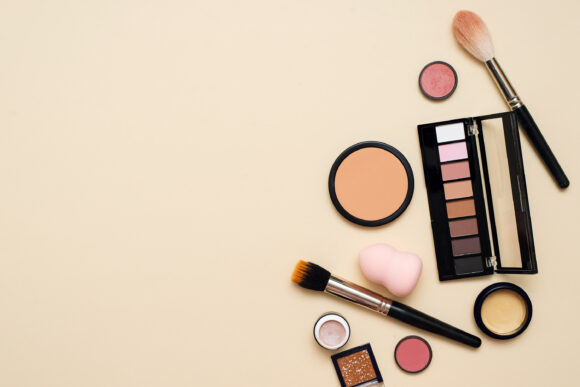More than half the cosmetics sold in the United States and Canada are awash with a toxic industrial compound associated with serious health conditions, including cancer and reduced birth weight, according to a new study.
Researchers at the University of Notre Dame tested more than 230 commonly used cosmetics and found that 56% of foundations and eye products, 48% of lip products and 47% of mascaras contained fluorine — an indicator of PFAS, so-called “forever chemicals” that are used in nonstick frying pans, rugs and countless other consumer products.
Some of the highest PFAS levels were found in waterproof mascara (82%) and long-lasting lipstick (62%), according to the study published this week in the journal Environmental Science & Technology Letters. Twenty-nine products with higher fluorine concentrations were tested further and found to contain between four and 13 specific PFAS chemicals, the study found. Only one item listed PFAS, or perfluoroalkyl and polyfluoroalkyl substances, as an ingredient on the label.
A spokeswoman for the U.S. Food and Drug Administration, which regulates cosmetics, said the agency does not comment on specific studies. The FDA said on its website that there have been few studies of the presence of the chemicals in cosmetics, and the ones published generally found the concentration is at very low levels not likely to harm people, in the parts per billion level to the 100s of parts per million.
A fact sheet posted on the agency’s website says that, “As the science on PFAS in cosmetics continues to advance, the FDA will continue to monitor voluntary data submitted by industry as well as published research.”
PFAS Ban
But PFAS chemicals are an issue of increasing concern for lawmakers who are working to regulate their use in consumer products. The study results were announced as a bipartisan group of senators introduced a bill to ban the use of PFAS in cosmetics and other beauty products.
The move to ban PFAS comes as Congress considers wide-ranging legislation to set a national drinking water standard for certain PFAS chemicals and clean up contaminated sites across the country, including military bases where high rates of PFAS have been discovered.
“There is nothing safe and nothing good about PFAS,” said Sen. Richard Blumenthal, D-Conn., who introduced the cosmetics bill with Sen. Susan Collins, R-Maine. “These chemicals are a menace hidden in plain sight that people literally display on their faces every day.”
Rep. Debbie Dingell, D-Mich., who has sponsored several PFAS-related bills in the House, said she has looked for PFAS in her own makeup and lipstick, but could not see if they were present because the products were not properly labeled.
“How do I know it doesn’t have PFAS?” she asked at a news conference Tuesday, referring to the eye makeup, foundation and lipstick she was wearing.
The Environmental Protection Agency also is moving to collect industry data on PFAS chemical uses and health risks as it considers regulations to reduce potential risks caused by the chemicals.
The Personal Care Products Council, a trade association representing the cosmetics industry, said in a statement that a small number of PFAS chemicals may be found as ingredients or at trace levels in products such as lotion, nail polish, eye makeup and foundation. The chemicals are used for product consistency and texture and are subject to safety requirements by the FDA, said Alexandra Kowcz, the council’s chief scientist.
“Our member companies take their responsibility for product safety and the trust families put in those products very seriously, she said, adding that the group supports prohibition of certain PFAS from use in cosmetics. “Science and safety are the foundation for everything we do.”
But Graham Peaslee, a physics professor at Notre Dame and the principal investigator of the study, said the cosmetics poses an immediate and long-term risk. “PFAS is a persistent chemical. When it gets into the bloodstream, it stays there and accumulates,” Peaslee said.
No specific companies were named in the study, although supporting material indicates that researchers tested dozens of brands, including many household names.
The study did not seek to link any health effects to cosmetics use, but Peaslee said researchers found PFAS levels that ranged from a few parts to billion to thousands of parts per billion. He called the latter totals “worrisome.”
The chemicals also pose the risk of environmental contamination associated with manufacturing and disposal, he said.
The man-made compounds are used in countless products, including nonstick cookware, water-repellent sports gear, cosmetics and grease-resistant food packaging, along with firefighting foams.
Public health studies on exposed populations have associated the chemicals with an array of health problems, including some cancers, weakened immunity and low birth weight. Widespread testing in recent years has found high levels of PFAS in many public water systems and military bases.
Blumenthal, a former state attorney general and self-described “crusader” on behalf of consumers, said he does not use cosmetics. But speaking on behalf of millions of cosmetics users, he said they have a message for the industry: “We’ve trusted you and you betrayed us.”
Brands that want to avoid likely government regulation should voluntarily go PFAS-free, Blumenthal said. “Aware and angry consumers are the most effective advocate” for change, he said.
Was this article valuable?
Here are more articles you may enjoy.



 Nearly Half of 100 Largest P/C Insurers Destroy Value: ACORD
Nearly Half of 100 Largest P/C Insurers Destroy Value: ACORD  Alliant Latest to Sue Howden US Over Alleged ‘Smash-and-Grab’ Poaching
Alliant Latest to Sue Howden US Over Alleged ‘Smash-and-Grab’ Poaching  Georgia Republicans Move to Scrap State Income Tax by 2032 Despite Concerns
Georgia Republicans Move to Scrap State Income Tax by 2032 Despite Concerns  Experian: AI Agents Could Overtake Human Error as Major Cause of Data Breaches
Experian: AI Agents Could Overtake Human Error as Major Cause of Data Breaches 

